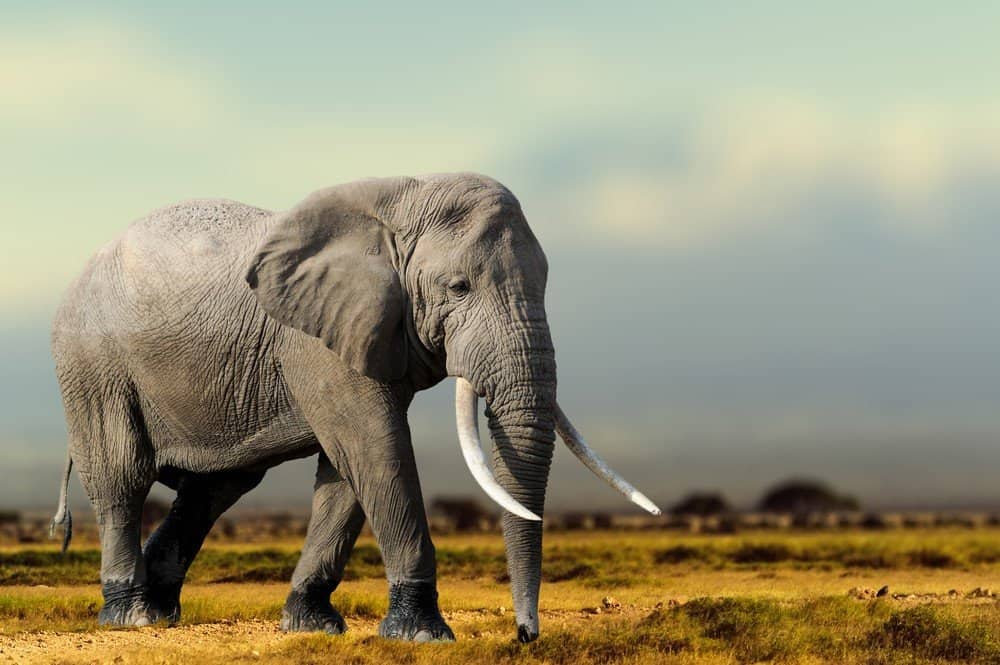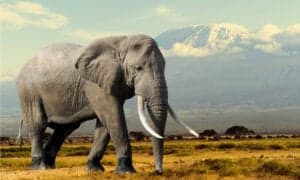Key Points:
- African elephants are the largest land-dwelling mammals on Earth. They can weigh up to 14,000 pounds.
- Hippos are highly aggressive creatures when they feel threatened and could be responsible for up to 3,000 fatalities every year.
- Both elephant and hippo populations are at risk due to habitat loss, poaching, and other factors.
Imagine being chased by a creature that weighs over 12,000 pounds. As it barrels toward you, you escape as fast as you can and wonder if you are any match for the beast. In this video, a huge elephant chases after a hippopotamus bathing in a nearby stream. For no apparent reason, the elephant charges at the hippo with all the force he can muster.
Watch This Angry Elephant’s Rampage Now!
At the start of the video, the elephant stomps along the streambank rapidly and plunges into the water after a hippo. The unexpecting hippo must think fast and begins to retreat from the angry elephant. The elephant nudges at the hippo’s back with his trunk, wanting him to move along. Splashing around, the two animals continue their chase through the water and, eventually, onto the streambank. While the hippo begins to slow in his retreat, the elephant comes up close behind, nudging him again to move along.

African elephants can weigh up to 14,000 pounds!
©Volodymyr Burdiak/Shutterstock.com
Background on Elephants
Elephants are the largest land-dwellers in the world, measuring between 8.2 and 13 feet high and weighing between 2.5 and seven tons. Elephants are herbivores, meaning their diets consists of vegetation only. The elephant shown in the video is likely an African elephant. African elephants are typically larger than Asian elephants. They also have larger ears than the Asian elephant.
There are two distinct types of African elephants. One belongs to the savanna while the other calls forested Africa its home. Savanna elephants are larger than forest elephants on average, and both groups are endangered. Endangerment of these two elephant species is an extremely unfortunate circumstance, as African elephants are considered keystone species. A keystone species is one that helps stabilize the entire ecosystem; without them, the ecosystem might not survive.
Background on Hippos
The hippopotamus is a large mammal that is also an herbivore, like the African elephant. Hippos can grow up to 16.5 feet in length and 5.2 feet in height. Hippos can also weigh up to 4.5 tons. The name hippo comes from the Greek term meaning “river horse,” as these creatures often dwell in the water. Shockingly, though, hippos can’t swim or float in water. Rather, they can nap in water due to a quality unique to their species.
Hippos are highly dangerous. While they may not show regular patterns of aggression, they will strike someone or something that threatens them. In fact, the chance of death when coming across a hippo is over 85%. Some have estimated that between 500 and 3,000 people die from a hippo encounter every year. Although hippos are not endangered, they are considered vulnerable because their population numbers are decreasing. Poaching and habitat loss are two major issues that have threatened hippo populations.
The photo featured at the top of this post is © Radek Borovka/Shutterstock.com
Sources
- Wonderopolis, Available here: https://www.wonderopolis.org/wonder/how-much-does-an-elephant-weigh
- National Geographic, Available here: https://www.nationalgeographic.com/animals/mammals/facts/african-elephant
- National Geographic, Available here: https://www.nationalgeographic.com/animals/mammals/facts/hippopotamus
FAQs (Frequently Asked Questions)
How large is the average elephant?
On average, African elephants weigh 12,000 pounds.
Are hippos aggressive?
Hippos are highly aggressive when they feel threatened or when their life is in danger.
Are elephants or hippos more dangerous?
Hippos are likely the more dangerous species between the two, as the chance of death from a hippo encounter is over 85%.
Thank you for reading! Have some feedback for us? Contact the AZ Animals editorial team.







